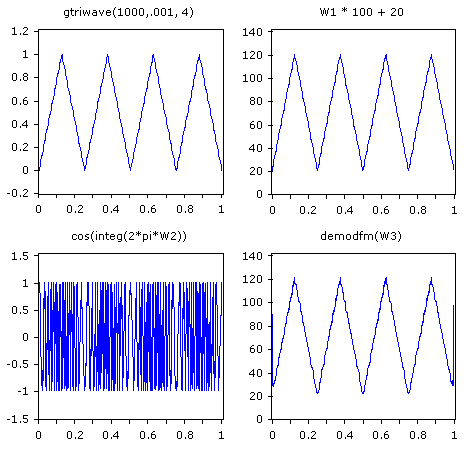
DADiSP Online Help
Click here to see this page in full context

DADiSP Worksheet Functions > Function Categories > Fourier Transforms and Signal Processing > DEMODFM
Demodulates an FM series using the Hilbert Transform.
DEMODFM(series, fmin, fmax)
|
series |
- |
A series or table. |
|
fmin |
- |
Optional. A real, the minimum modulation frequency used to scale the result. If not specified, no output scaling is performed. |
|
fmax |
- |
Optional. A real, the maximum modulation frequency used to scale the result. If not specified, no output scaling is performed. |
A series or array.
W1: gtriwave(1000,.001, 4)
W2: W1 * 100 + 20
W3: cos(integ(2*pi*W2))
W4: demodfm(W3)

W2 represents the scaled information signal and W3 is the resulting frequency modulated signal. The amplitude of W2 determines the instantaneous frequency of W3. The instantaneous frequency of W3 ranges from:
min(w3) == 20 Hz
to
max(w3) == 120 Hz
W4 is the unscaled demodulated result.
W1: gtriwave(1000, .001, 4)
W2: modfm(w1, 20, 100)
W3: demodfm(w2)
W4: demodfm(w2, 20, 100)
Same as above except the minimum and maximum modulation frequencies are specified in W4 to scale the result.
DEMODFM uses HILB to calculate the Hilbert Transform.
See MODFM to frequency modulate a series.
See GSWEEP to generate a linearly swept sinewave.
See DEMODAM to demodulate an amplitude modulated series.